England v India: Should cricket introduce red and yellow cards?
- Published
- comments
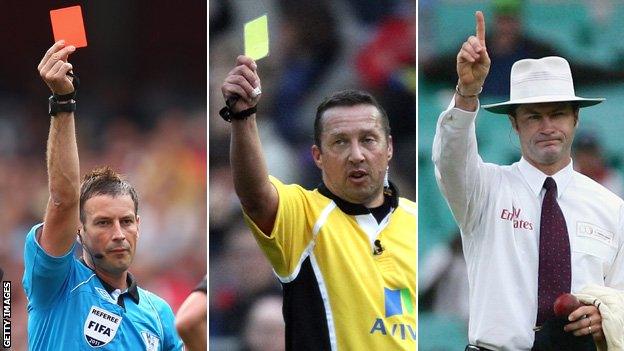
The fracas between England's James Anderson and India's Ravindra Jadeja during the first Test at Trent Bridge has raised the question: is cricket too soft on bad behaviour?
Unlike in most other team sports, cricket umpires have no power to eject players from the field of play, with any penalties imposed by officials - such as the International Cricket Council's match referees - after the match.
Introducing football-style red and yellow cards would enable umpires to deal with misdemeanours as and when they occurred, but would be a fundamental change to a sport proud of its gentlemanly traditions.
The concept has been frequently considered by the MCC and was discussed by the ICC earlier this year.
Here are the cases for and against, plus your chance to have your say.
FOR - Test Match Special commentator Prakash Wakankar
Behaviour on a cricket field is getting worse and will continue to get worse unless the umpires are given more power to intervene.
We need a system that operates throughout the formative years of a cricketer's career and acts as a deterrent against bad behaviour. Players need to understand that if they behave in a certain way they will be punished, and if they repeat their offence then the punishment will escalate.

Wakankar has been commentating on cricket for 29 years and now works for TMS and All India Radio
That is where the idea of red and yellow cards comes in. It may sound radical but they said the same about bringing in coloured clothing 20 or so years back.
The exact working of the system would need more thought and discussion, but I would suggest a yellow card should be shown to a bowler for persistently abusing a batsman. I am not talking about sledging, but personal abuse and foul language that has no place in the game.
The card would result in them having to leave the field at the end of the over for a fixed period of time. If that bowler was in the middle of a great spell, or if the captain has a strategy based around him, it could be really harmful to the team. That evening, in the team meeting, the player could be singled out for having cost his side the game.
Did you know? |
|---|
Red and yellow cards were devised by English football referee Ken Aston - who officiated in the notorious 1962 World Cup game between Chile and Italy which became known as the Battle of Santiago - when he was waiting at a set of traffic lights. They were introduced at the 1970 World Cup and have been adopted worldwide since, with variants appearing in many other sports. |
If a batsman is repeatedly wasting time, then the umpire could show him a yellow card, meaning he is is retired for an hour or until the next wicket falls. If a fielder misbehaves, he is demoted down the batting order, and so on.
And if something really serious happens - I'm thinking of the infamous dust-up between Javed Miandad and Dennis Lillee or something equally inexcusable - then the umpires would show a red card and you'd be out of the match.
This can all be refined, but the fundamental aim is to handle misdemeanours on the field and let the umpires be the boss on the cricket pitch.
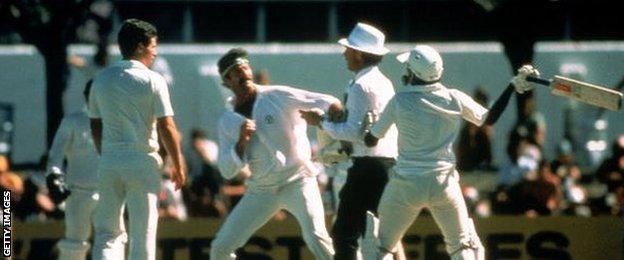
Dennis Lillee of Australia and Javed Miandad of Pakistan clashed at the Waca during a 1981 Test
Let's keep the lawyers out of this. No-one is killing anybody, after all. Let the umpire take charge in the same way that the referee does in football, rugby or hockey. Why should cricket be different?
Waiting until after the game and then issuing a fine achieves nothing. Unless the punishment causes hurt where it hurts, it has no effect.
Look what happened to South Africa fast bowler Vernon Philander in Sri Lanka. He was accused of ball-tampering, and it was established that he tampered with the ball and yet what did he get? A fine of 75% of his match fee.
I don't know whether he writes the cheque or whether his board pays it for him, but either way it's no deterrent to anyone thinking of tampering with the ball.
Introducing cards would add another level of theatre to the game, but that is merely incidental. The important thing is to make sure the game is played the way it is supposed to be played.
If you introduced red and yellow cards from the grassroots of the game, players would learn to respect their opponents and avoid the kind of behaviour that might see them have to leave the field.
Make the umpire the boss and it will remove all the animosity that is blighting our game.

Cyril Mitchley gives West Indies batsman Philo Wallace a yellow card as a joke in 1998 after the umpire had to take evasive action and leap out of the way to avoid a boundary shot
AGAINST - Ex-England pace bowler Steve Harmison
Introducing red and yellow cards to cricket would set a dangerous precedent and take the game to places you shouldn't be taking it.
First and foremost, it would undermine the umpires. You are more or less saying that they are not strong enough and the authorities are not doing enough to stamp out issues.

Steve Harmison took 226 wickets in 63 Tests for England between 2002 and 2009
What would you be bringing them in for? There is never any physical contact on the cricket field and I don't think there ever will be, so it seems over the top to me.
The James Anderson-Ravindra Jadeja incident happened off the field of play and was not seen by umpires, so there is no way they could have shown a card.
If it is for verbals or time-wasting then the umpires should be strong enough, and have been strong enough, to stamp out misdemeanours with a stern word or a fine.
There is a difference between sledging and personal abuse. For example, England have no doubt been chipping away at India opener Shikhar Dhawan, telling him he is playing for his place, jokingly urging him not to nick it.
India will be saying the same to Sam Robson, telling him he'd better score some runs or he'll be back playing first-class cricket for Middlesex. It is light-hearted banter which is part of the game.
But the minute you start effing and blinding and being personal, you have gone over the line and the umpire has to be strong to stamp it out.
MCC on red and yellow cards |
|---|
Fraser Stewart, MCC cricket academy and laws manager: "The issue of red and yellow cards has been discussed at a number of committee meetings, but it is not something we are looking to implement at the moment. Through the MCC Spirit of Cricket we encourage cricketers to play hard and fair. We certainly don't want top-level cricket to lose that competitive edge but it is important that international cricketers remember they are role models. Umpires at all levels must try to be firm in controlling behaviour and, if necessary, nipping any potential conflict in the bud." |
In this series, the umpires have been fantastic. In Southampton, when Jimmy was dishing it out to Ajinkya Rahane, umpire Rod Tucker intervened and told him to cut it out. Jimmy went back to his mark chuntering away to himself, got it out of his system and bowled another ball.
I'm all for technology and making sure the game keeps up with the times, but red and yellow cards is a step too far. It would cause a lot of controversy, and stoke up tensions between the teams.
In football, there are written laws that dictate when to use a yellow or a red card but in cricket - the sport I love and played - the umpires have always used common sense to police the game.
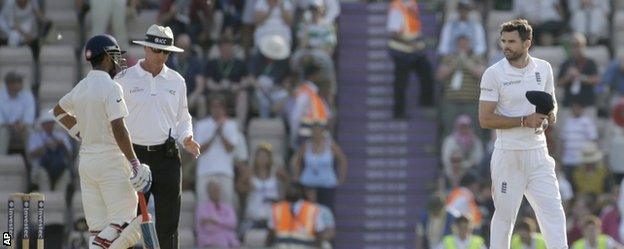
Umpire Rod Tucker steps in to defuse a row between Ajinkya Rahane and James Anderson
If someone has overstepped the mark, the umpire should just have a quiet word with him. Tell him he was out of order and if he does it again he might get hit in the pocket. If you go any further you will be going to the match referee's office and could receive a ban. That should be enough of a threat because nobody wants to be suspended for a game of cricket.
If you start using a sin bin to take bowlers and batsmen off the field, you are cheating the public, who already pay far too much to come and watch cricket.
Red and yellow cards would just be another gimmick that would go against the traditions of cricket. Let's encourage the umpires to be strong and police the game out in the middle.
- Published7 August 2014
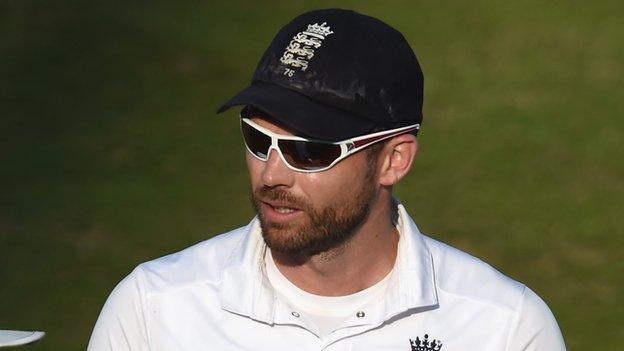
- Published6 August 2014

- Published1 August 2014
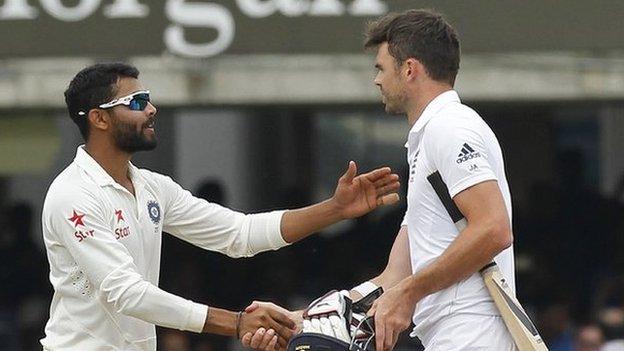
- Published18 October 2019
